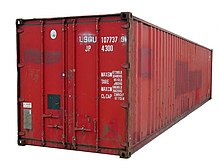This article may be in need of reorganization to comply with Wikipedia's layout guidelines. (February 2023) |


An intermodal container, often called a shipping container, or cargo container, (or simply “container”) is a large metal crate designed and built for intermodal freight transport, meaning these containers can be used across different modes of transport – such as from ships to trains to trucks – without unloading and reloading their cargo.[1] Intermodal containers are primarily used to store and transport materials and products efficiently and securely in the global containerized intermodal freight transport system, but smaller numbers are in regional use as well. It is like a boxcar that does not have wheels. Based on size alone, up to 95% of intermodal containers comply with ISO standards,[2] and can officially be called ISO containers. These containers are known by many names: freight container, sea container, ocean container, container van or sea van, sea can or C can, or MILVAN,[3][4] or SEAVAN.[citation needed] The term CONEX (Box) is a technically incorrect carry-over usage of the name of an important predecessor of the ISO containers: the much smaller steel CONEX boxes used by the U.S. Army.
Intermodal containers exist in many types and standardized sizes, but 90 percent of the global container fleet are "dry freight" or "general purpose" containers:[2][5] durable closed rectangular boxes, made of rust-retardant Corten steel; almost all 8 feet (2.44 m) wide, and of either 20 or 40 feet (6.10 or 12.19 m) standard length, as defined by International Organization for Standardization (ISO) standard 668:2020.[2][6] The worldwide standard heights are 8 feet 6 inches (2.59 m) and 9 feet 6 inches (2.90 m) – the latter are known as High Cube or Hi-Cube (HC or HQ) containers.[7] Depending on the source, these containers may be termed TEUs (twenty-foot equivalent units), reflecting the 20- or 40-foot dimensions.
Invented in the early 20th century, 40-foot intermodal containers proliferated during the 1960s and 1970s under the containerization innovations of the American shipping company SeaLand. Like cardboard boxes and pallets, these containers are a means to bundle cargo and goods into larger, unitized loads that can be easily handled, moved, and stacked, and that will pack tightly in a ship or yard. Intermodal containers share a number of construction features to withstand the stresses of intermodal shipping, to facilitate their handling, and to allow stacking. Each has a unique ISO 6346 reporting mark.
In 2012, there were about 20.5 million intermodal containers in the world of varying types to suit different cargoes.[6][nb 1] Containers have largely supplanted the traditional break bulk cargo; in 2010, containers accounted for 60% of the world's seaborne trade.[9][10] The predominant alternative methods of transport carry bulk cargo, whether gaseous, liquid, or solid—e.g., by bulk carrier or tank ship, tank car, or truck. For air freight, the lighter weight IATA-defined unit load devices are used.
- ^ Lewandowski, Krzysztof (2016). "Growth in the Size of Unit Loads and Shipping Containers from Antique to WWI". Packaging Technology and Science. 29 (8–9): 451–478. doi:10.1002/pts.2231. ISSN 1099-1522. S2CID 113982441.
- ^ a b c Cite error: The named reference
Production2007was invoked but never defined (see the help page). - ^ "M: MILVAN : military van (container)". Military Dictionary. MilitaryFactory.com. Retrieved 29 November 2021.
Military-owned, demountable container, conforming to US and international standards, operated in a centrally controlled fleet for movement of military cargo. Also called MILVAN.
- ^ "NSN: 8145-01-C00-8991 (CONTAINER SHIPPING AND STORAGE: 20 FT MILVAN)". ArmyProperty.com. Archived from the original on 29 November 2021. Retrieved 29 November 2021.
- ^ Cite error: The named reference
ShipCouncilFleetwas invoked but never defined (see the help page). - ^ a b "World Container Fleet Overview". csiu.co. CSI Container Services International. January 2014. Archived from the original on 8 March 2022. Retrieved 9 March 2022.
- ^ "Container sizes". Shipsbusiness.com. Retrieved 1 February 2013.
- ^ Container Supply Review (PDF) (Report). World Shipping Council. May 2011. p. 1. Retrieved 18 July 2015.
- ^ "Container Shipping – Statistics & Facts". Statista.com. Statista Inc. Archived from the original on 5 December 2014. Retrieved 27 July 2015.
- ^ Global Trade – World Shipping Council
Cite error: There are <ref group=nb> tags on this page, but the references will not show without a {{reflist|group=nb}} template (see the help page).